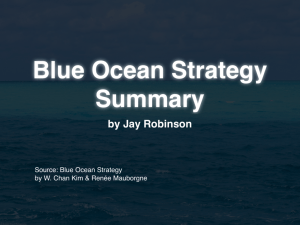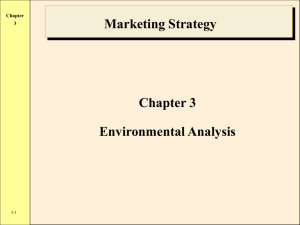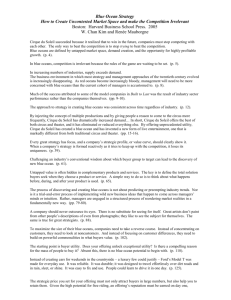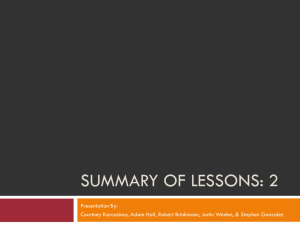Blue Ocean Strategy
advertisement
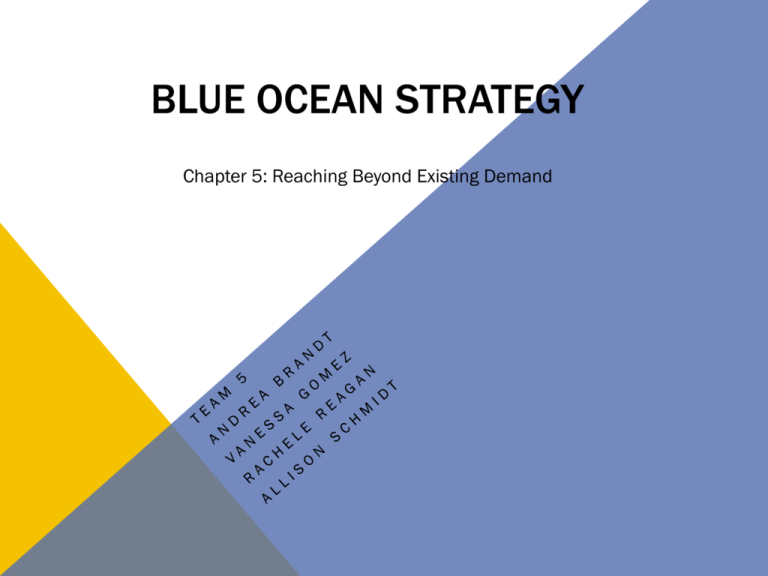
BLUE OCEAN STRATEGY Chapter 5: Reaching Beyond Existing Demand PRINCIPLES OF BLUE OCEAN STRATEGY • Formulation Principles • Reconstruct market boundaries • Focus on the big picture, not the numbers • Reach beyond existing demand • Get the strategic sequence right • Execution Principles • Overcome key organizational hurdles • Build execution into strategy REACHING BEYOND EXISTING DEMAND • Reaching beyond existing demand is the third principle of blue ocean strategy, a key component of achieving value innovation, and weakens the scale risk affiliated with creating a new market • It shows you how to maximize the size of the blue ocean you are creating • Usually to increase its market share, firms will strive to retain and expand its existing customers • This leads to finer segmentation and modifying offerings to meet customer preferences • Therefore, as competition intensifies this customization will increase also and risk the creation of too-small target markets OPPOSITE APPROACH • Too combat these issues, firms need to take the opposite approach • Firms must challenge those two conventional strategy practices: • Focusing on existing customers • concentrate and look to noncustomers • Driving for finer segmentation to accommodate buyer differences • find and build on the dynamic commonalities that buyers value • Callaway Golf decided to ask why people had not taken up golf and discovered the commonality that many found hitting a small golf ball to be too difficult • Callaway’s solution was to introduce the Big Bertha golf club which had a larger head to make it easier to hit a golf ball • Ended up being a big hit with noncustomers as well as existing customers who were having trouble mastering the skills needed to hit the ball consistently THE THREE TIERS OF NONCUSTOMERS Third Tier • There are three tiers of noncustomers that can be transformed into customers • The tiers differ in their relative distance from your market Second Tier First Tier Your Market FIRST-TIER NONCUSTOMERS • “soon-to-be” noncustomers on the edge of your market, who minimally use the current market offerings waiting for something better to come along • Pret A Manger, a British fast-food chain, discovered professionals preferred a healthier, quicker, less expensive option for lunch as opposed to a pricey, time consuming sit-down restaurant • Their solution: provide restaurantquality sandwiches that are made fresh each day, cost on average $4-$6 and spend on average only 90 second in line SECOND-TIER NONCUSTOMERS • “refusing” noncustomers who consciously choose against your market because they do not use or cannot afford the markets offerings so their needs or either ignored or dealt with in other means • The designer clothing industry has ignored the needs of many American women. The average American woman wears a size 14 dress but this is considered “plus-size” and many manufactures don’t produce clothing past size 12. THIRD-TIER NONCUSTOMERS • “unexplored” noncustomers who have either not been targeted or thought of as potential customers because their needs have always been assumed to belong to other markets • In the last decade, with consumer preferences changing to healthier products, a new segment of nonconsumers has been uncovered VS. VS. Introducing… Girl Watching GO FOR THE BIGGEST CATCHMENT • The potential in each tier varies across time and industries, therefore focus should be aimed at whatever tier represents the largest potential at the time • Also explore the idea that some tiers have commonalities that may overlap which can expand the scope of latent demand you release • Making the strategic decision not to explore noncustomers can result in: • Your market share becoming smaller and smaller due to increasing segmentation and customization • Competitors could attract the noncustomers and potentially your existing customers with value innovation • Ex: Aquafina vs. Dasani
